A UNESCO World Heritage City, surrounded by mountains and sitting at the junction of the Mekong and Nam Khan rivers, is the ancient royal city of Luang Prabang.



After disembarking from our river cruise, we caught a shuttle van to our hotel in Luang Prabang. We were staying at a great little guesthouse on the Nam Khan Riverside called Villa Ouis NamKhan. Oddly, it was being run by a Vietnamese guy. He was so nice and helpful. We had to use our Google translators with each other a few times, but that’s okay. The rooms were great and it included a really good, free breakfast. After dropping our bags we headed straight to the French Bakery for coffee, eggs and croissants. We had been here a number of times on a previous visit to Luang Prabang and knew just how good it was. Plus we could sit at a small sidewalk table and look directly across the street at a beautiful temple and its statues. Like Vietnam, Laos retains their French influence and it really comes through in their breads and pastries. I visited Luang Prabang about nine years ago and was captivated by its mysterious feel, quaint charm, and tranquil beauty. Most places change over time and I was a little worried that Luang Prabang might have lost some of its charm. I was pleasantly surprised to find that it had not.

Luang Prabang is beautiful with its French colonial architecture. What really stands out for me is the temples, with 33 of them, this is truly a city of temples. Once known as the City of A Million Elephants, Luang Prabang was founded over 1,200 years ago and some of the temples here are well over 500 years old. They are all beautiful to look at with their steep multi-tiered roofs, and maroon walls with gold trim. Built in 1763, Wat Syrimoungkoun Xaiyaram is a very interesting place with several different temple buildings, an array of statues, and some very old chedi. Located right on Main Street, it is free to visit and wander the grounds. Visiting a temple always gives me the most peaceful feeling. We visited at least one every day, some days two or three. There is a special vibe that can’t be explained, when walking around one of these ancient temples. The old chedi or stupas at the temples are definitely worthy of investigating. Made of chiseled stone or concrete, a stupa is where the urn containing a deceased persons ashes are kept. In Laos, many of these are tall, slender and elegant shaped. They can also be bell shaped. I found that some of the really old ones had the persons likeness carved into the stone. The next oldest had small framed portrait drawings of the person behind glass. The next oldest were Daguerrotypes, followed by different types of old black and white photography that came after. These continued right up to a modern, color photo of the person. I found it very interesting.

Wat Xieng Thong Sayaroharamatibodimahavihanh (what?), known locally as just Wat Xieng Thong, is another very ancient and principal temple here in Luang Prabang. This “Temple of the Golden City” as the name translates, was built in 1559, this is one of the most important of Lao monasteries and remains a significant monument to the spirit of religion, royalty, and traditional art. Ancient kings were crowned here and it retains a library for ancient scriptures. It is also a showcase for Laos traditional architecture. This place should not be missed!





The most attractive temple here in Luang Prabang is the Haw Pha Bang, which translates to “Royal Temple”, which sits on the grounds of the Royal Palace. This beautiful and ornate temple was built to house Laos’ most sacred Buddha image, the Phra Bang Buddha. This is the image for which the town of Luang Prabang was named back in the 1300s. This 32 inch gold statue of the Buddha was made in Sri Lanka. The King of Angkor gave it to the then King of Luang Prabang in 1353. On two separate occasions over the centuries, the statue was stolen by invaders from Siam (now Thailand). It was returned to Luang Prabang in 1867 and remains here today on a very ornate gilded alter inside the temple. Both beautiful and fascinating.



The morning market here makes for a fun and interesting way to start the day. Located on a few side streets near the Royal Palace, this market starts bright and early at 5:00 am and is wrapping up by 10:00 am. We went on several different days and tried to get there by 7:30 or 8:00 am. You can find souvenir items, leather and woven bags, and traditional lacquerware, along with handmade items such as the beautiful, and colorful, traditional Saa paper umbrellas. The ladies here have garden fresh vegetables and herbs. The mounds of ripe tomatoes, red and green chili peppers, purple eggplants, and multi-colored squash are beautiful to look at. There are several fresh flower vendors as these are used for offerings at the temples. You can also find fresh fish of several varieties, clams, snails, and shrimp all from the river. There is variety of fresh meat and sausages, live ducks, frogs, turtles, you name it, so much can be found here.
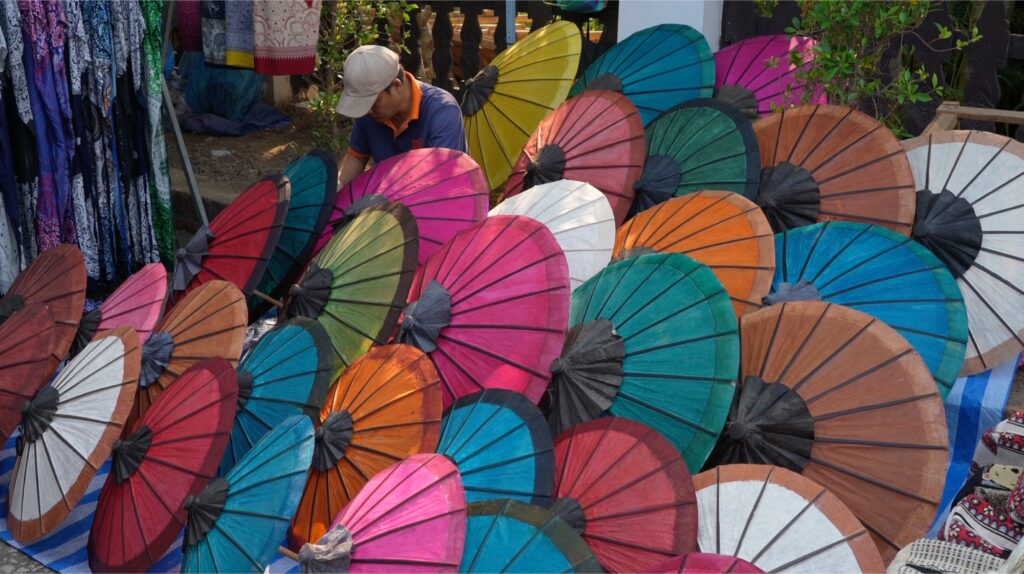



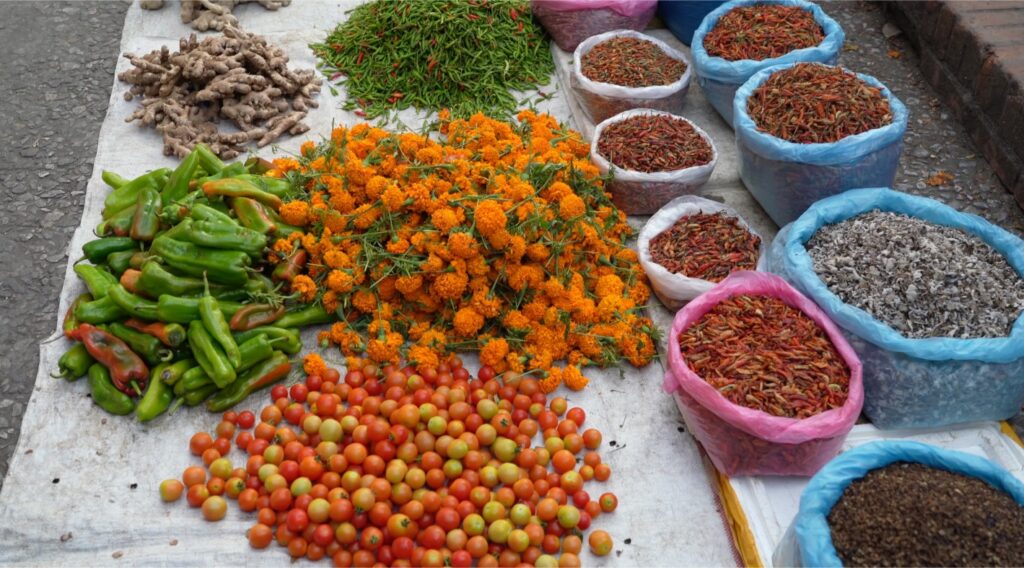

I love looking at all the mornings offerings, but what brings me here is really the food. There are so many delightful and tasty things to eat. My all time favorite is a type of pork sausage they sell by the gram. The vendor grills it over charcoal and gives it to you piping hot and dripping with juices. It was so delicious, very reminiscent of kielbasa, only better! I also had cocoanut pancakes, thick and dense, but very filling and very delicious. I found the tastiest treat in what looked like little donut holes but were made with bananas and cocoanut and tasted like banana bread. I’m glad I only bought two because I could have eaten a dozen. I followed this up with a fresh squeezed orange juice. I believe the variety of oranges here are called Makpaen. Their flesh and juice is so bright, it’s almost a neon orange color. Until I saw the vendor squeezing them, I did not think this was fresh orange juice, but just another artificial flavored, sugar laden drink. When I saw that this was actually fresh squeezed juice, I had to try it and it was truly the best orange juice I have ever had. Naturally sweet with just a hint of tart. I am a bit of an adventurous eater, so when we saw a woman grilling small yellow squares of something, then wrapping it in banana leaf to keep warm, we were intrigued and had to go over and check it out. Whatever it was smelled wonderful. Turns out it was honeycomb, with the bee larvae still inside the comb. I was game to try some. I probably wouldn’t have if it hadn’t been grilled. It smelled so good, I didn’t hesitate unwrapping it and taking a bite. The texture was fine, and it wasn’t sweet at all. It actually tasted like scrambled eggs with the essence of flowers. I can see why it’s considered a delicacy.
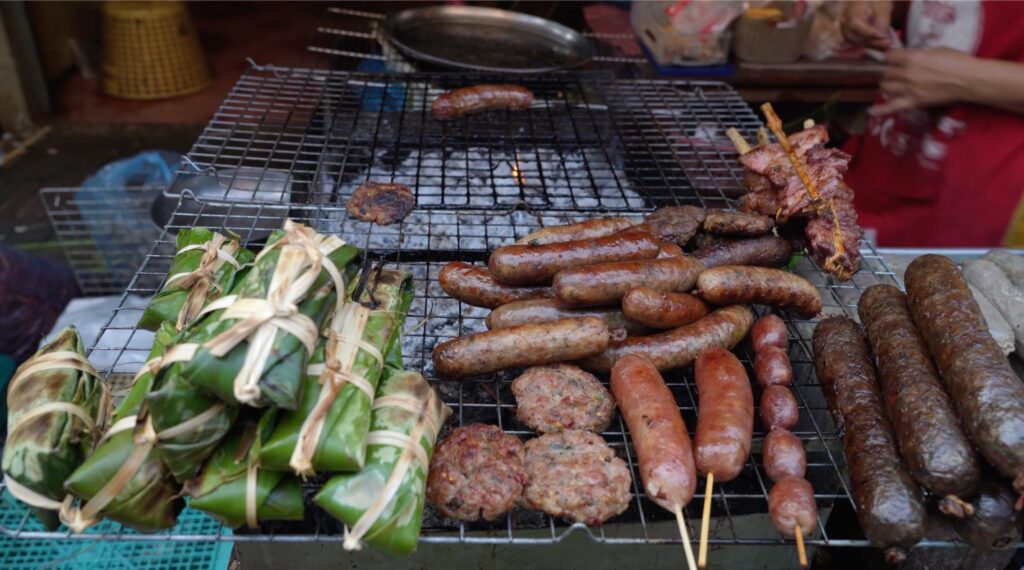






There is also a night market that runs from about 5:00-11:00 pm. Wow, you can find anything you want to eat here! I discovered one of the best salad bars I have ever seen here, and I visited it multiple times. You can also get any type of meat or fish. It seemed like most of the meat came on skewers and was grilled to perfection. You can also get any type of dessert you can dream of cakes, pies, cheese cake, cookies, ice cream. I opted for the fresh fruit smoothies knowing that most places I go do not have access to this array of exotic tropical fruits. This market isn’t just food either. You can find everything from beautiful handcrafted items to souvenir t-shirts. It really made for a fun evening whenever we went.

I found the variety of foods out drying in the sun here so interesting. You can just be walking down a neighborhood street and someone will have racks of sausages out drying in the sun, or trays full of rice cakes and rice crackers. You can also see the pork strips that will later be marinated and fried, along with water buffalo, and kai pen which is a river seaweed that is seasoned, dried, pressed into sheets and is popular to eat when drinking Lau-Lau (rice whiskey).


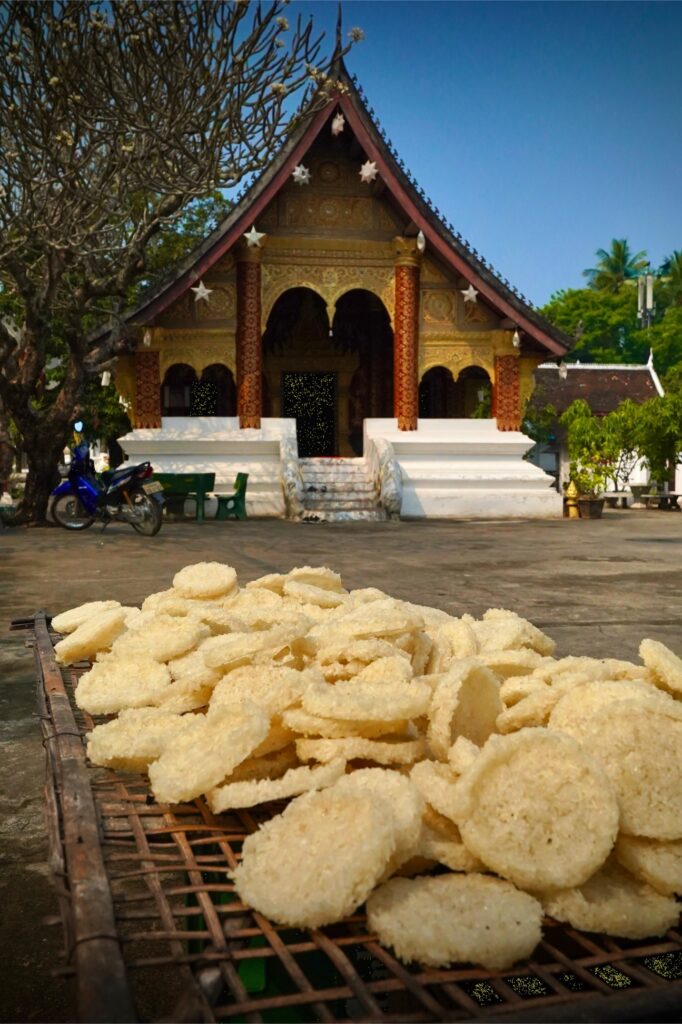

One morning we arranged a trip to the famous Kuang Si waterfalls. We had been there before but it is such a lovely place we wanted to go back. We got a ride in the back of a small pick-up truck outfitted with benches. It took a good hour and a half to get there. Not because it’s far but because of the condition of the road. Upon arriving, we could not believe the change that had taken place outside the falls. Previously, it had been a dirt road going off the highway, with a few small places to eat outside of the entry gate. The entry gate was very close to the falls and had a few changing rooms so you could put your swimsuit on. Now a paved road takes you all the way in. There is a very large, paved parking area, proper turnstiles, ticket booth, along with new and modern restrooms and changing facilities. We couldn’t believe the transformation on the outside. Luckily the inside was still just as beautiful. The water coming down from the mountains and over the falls is a milky turquoise color, because of minerals in the water. Everything was green as it is surrounded by jungle forests. We hiked up to the top of the falls, which has a 200 foot drop. There was a great look-out spot up there and some swimming holes. After the 200 foot drop, the falls have a few smaller drops into pools that are good to swim in and are filled with those little fish that give you a pedicure by eating all the dead skin off your feet. The water is pretty chilly, so most people don’t stay in to long. There is a really nice bridge you can get great photos of the falls from along with some nice rocky outcroppings. It is just a beautiful place to visit. We were lucky as there weren’t really very many people here on this day.



There is also a moon bear rescue center next to the falls. These are small bears that are rescued from bile farms and injured by hunters. They are actually very cuddly looking lying curled up in the sun or climbing around the rocks in their enclosure. Their fur is all black with a white crescent moon shape on their chest, just below their neck. The government has teamed up with some NGOs to provide rescue facilities and public education to try and stop bile farming. Our outing was unfortunately marred by me losing my iPhone. We hit some big bumps on our way up to the falls and it bounced out of my unzipped daypack pocket, onto the roadside somewhere. Talk about feeling like a bonehead, I really did! After discovering it missing and searching the truck that took us out there, we went back to our guesthouse. I knew it wouldn’t be there, and it wasn’t. So we got a Tuk-Tuk to take us back up the same road. The driver went up and down the road several times helping us look. The Find My Device app on my iPad showed the phones location. That is where we went, but there are so many steep roadside drop-offs and so much over growth on the sides of the roads that it was impossible to pinpoint it. I imagine it was busted up pretty well. To this day my app shows that it is still in the same spot where it landed. I guess it will never be found. Even though it only opens with my fingerprint, I still changed all the passwords to my apps. Sometimes unfortunate incidences happen when you’re traveling, just like they do at home. I would have to wait until we were back in Bangkok to find an Apple Store and replace my phone.

One of the most fascinating things to see here is the daily alms ceremony, or Sai Bat. This silent ceremony begins at sunrise every day, so around 5:30 am. This enlightening ritual really is something to see, and should definitely be experienced while in Luang Prabang. Imagine a long procession of barefoot, saffron robed monks, slowly coming out of the morning mist as they proceed single file up the Main Street, passing ancient temples and monasteries. With each monastery they pass, more monks join their ranks. Several hundred monks from 30 different monasteries to be exact. The devout kneel on mats at the roadside to give their alms to the monks. Alms are in the form of food. Normally sticky rice balls, packets of cooked vegetable, fruit, crackers, etc. These items are placed into special baskets the monks are each carrying. Devotees offer their alms to the monks in order to gain good karma or merit for their next life. After reaching the end of the Main Street, the monks spread out into the side streets. They are generally finished by 7:30 and return to their monasteries to eat. The offerings they collect are turned into their breakfast and lunch. Being Theravada Buddhists, all their food for the day must be consumed by 11:00 am and they do not eat again until after collecting alms again the next day. This morning tradition here in Luang Prabang dates back to the 14th century, and has gone unbroken for hundreds of years. I observed some very poor and homeless waiting at the very end of the monks procession. The monks shared what they had collected for themselves to eat with these less fortunate people.

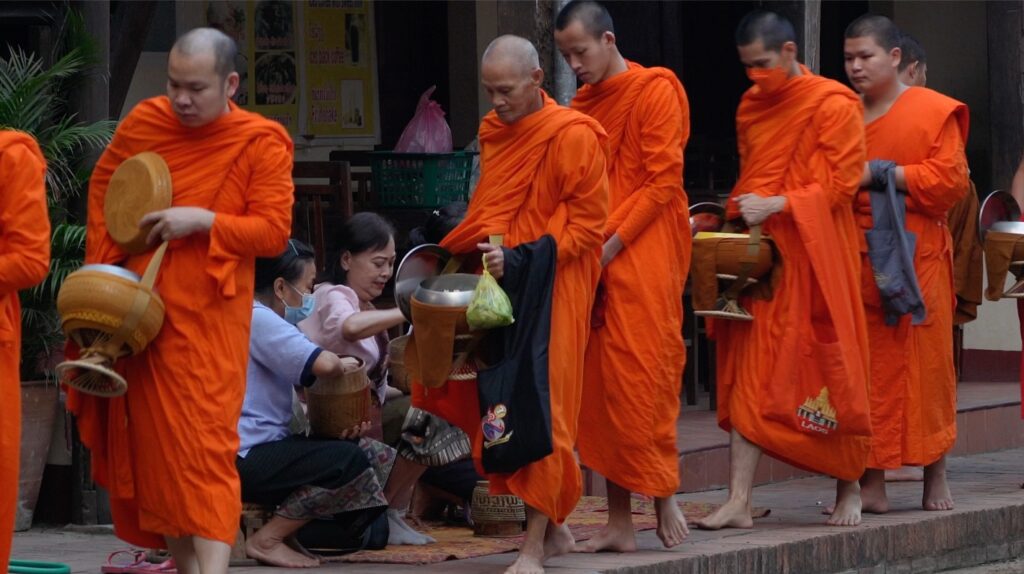



There are signs up and down Main Street about how to be respectful of this ancient ceremony. Tourists are requested to be quiet, dress modestly, no flash photography or approaching the monks closely to snap photos. Remain at a respectful distance and do not get in the way. These rules have to be posted for those that don’t know how to behave, you could also end up paying a fine.
There is the small, but very informative, UXO Visitors Center. This is the Museum of Unexploded Ordinance leftover from “The Secret War” that the people of Laos were left to deal with. You can see many types of ordinance on display that has been dug up here, along with some very emotional videos. Two million tons of ordinance was dropped on Laos between 1964-1973, and 30 percent of it failed to detonate. The worst is the cluster bomb. This is a big bomb filled with 90 little “bommies”. These just happen to look like a fruit or a toy. When it rains and some get washed up, children see them and pick them up, and they go off. Or, a farmer plowing his field hits one with his plow, or a woman planting her garden hits one with a shovel. This place really showcases the horrors of war, in a country where there was not supposed to be any fighting or bombing going on. We saw many adults of all ages and children missing arms and legs. You can’t believe how common it is. The U.S. gives $6.5 million dollars a year to an ongoing project that has been methodically working its way across the affected areas of the country. The workers for this project detect for unexploded ordinance and disarm it and dispose of it. They employ the use of x-ray, and dogs and rats that have been trained to sniff out UXO. I found it heartbreaking and had to fight back my tears.


While out walking on the riverfront promenade late one morning we started talking about where we wanted to eat lunch. Right at that exact moment we walked up to a sign that said “Be adventurous, cross the river”. It was an advertisement for a restaurant called Dyen Sabai. All we had to do was walk down the stairs to a small dock at the rivers edge and a motorboat came over from the opposite side of the river to pick us up. The boat across costs .35 cents, which they deduct from the cost of your meal. After getting off the boat, we walked up a small hill with several shops, a little art gallery, and a handmade jewelry store. The restaurant at the top was really nice, built with various levels of platforms, with low tables and cushions to sit on. We were surrounded by shady trees and had a nice view of the river. The food here was great. One of my favorites was the sun-dried pork strips, marinated, fried and then sprinkled with sesame seeds. I also had a great dish of sticky rice with grilled eggplant, and a really tasty salad of Mekong River seaweed with sesame seeds. It was so delightful, we came back a couple more times. Aaron’s favorite was the Stir-Fried Water Buffalo. They also served a very refreshing Lime Daiquiri, always buy one get one free! Almost essential on a hot day, I really enjoyed those as well.





One of my favorite things that I did here was to volunteer one evening at the Big Brother Mouse program. This is a non-profit publishing project that publishes books to improve literacy, and especially to get books into the hands of children in rural villages. Here in Luang Prabang, elementary school children come after school to read. In the evening, which is when I volunteered, high school and college students come in to practice their English with English speaking volunteers, and to ask questions. I first spoke with a young man that was working his way through college, one class at a time. He has to work full-time and can only afford one class that he can attend at night. He is studying to become a tour guide, which is a pretty good job here. Next I spoke with a young woman who was going to college during the day and worked in the kitchen of a resort here on the weekends. She really did have some good English skills. I also was able to sit and talk with one of the young men from Laos that helped get this program going. He was able to study and get his college degree in Canada. Then he joined up with this program and came back to Laos and now takes the program out into the rural villages. They also do things in these villages like digging wells for fresh water and bringing in mobile doctors on a regular basis. It really is a great program.



Our visit to Luang Prabang was a whirlwind. I feel so lucky that I have been able to come here twice and spend some time. I discovered so much on this visit that I missed on our first one. If you visit SE Asia, put Luang Prabang on your itinerary. It is so worth visiting.
CHECK OUT OUR LUANG PRABANG VIDEO


